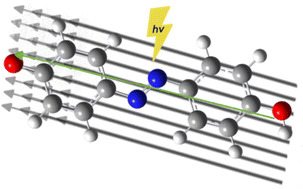Protonation state control of electric field induced molecular switching mechanisms†
Abstract
Scanning tunneling microscopy tip-induced deprotonation has been demonstrated experimentally and can be used as an additional control mechanism in electric-field induced molecular switching. The goal of the current work is to establish whether (de)protonation can be used to inhibit or enhance the electric field controlled thermal and photoisomerization processes. Dihydroxyazobenzene is used as a model system, where protonation/deprotonation of the free hydroxyl moiety changes the azo bond order, and so modifies the rate of electric field induced isomerization. Through the combined action of deprotonation and applied field, it was found that the cis-to-trans thermal isomerization barrier could be completely removed, changing the isomerization half-life from the order of several months. In addition, due to the presence of multiple isomerization mechanisms, electric fields could modify the isomerization kinetics by increasing the number of energetically viable isomerization pathways, rather than reducing the activation barrier of the lowest energy pathway. Excited state calculations indicated that the protonation state and electric field could be used together to control the presence of electronic degeneracies along the rotation pathway between S0/S1, and along all three pathways between S1/S2. This work provides insight into the mechanisms that enable the use of protonation state, light, and electric fields in concert to control molecular switches.



 Please wait while we load your content...
Please wait while we load your content...